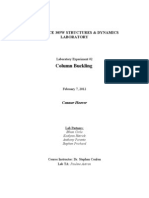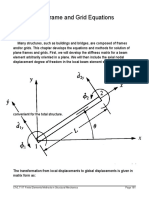Beam Element Example
Beam Element Example
Uploaded by
Azim SamiinCopyright:
Available Formats
Beam Element Example
Beam Element Example
Uploaded by
Azim SamiinCopyright
Available Formats
Share this document
Did you find this document useful?
Is this content inappropriate?
Copyright:
Available Formats
Beam Element Example
Beam Element Example
Uploaded by
Azim SamiinCopyright:
Available Formats
Example
Consider a simply-supported beam structure under distributed load q, as shown in
Figure 1.
q
E,I,L
Figure 1 One element model with distributed force q
The whole structure is approximated using one beam finite element. Since no
nodal forces exist, the finite element equation can be written as
1
2 2 2
1
3
2
2 2 2
2
12 6 12 6 / 2
6 4 6 2 /12
12 6 12 6 / 2
6 2 6 4 /12
v L L qL
L L L L qL
EI
v L L qL L
L L L L qL
(
(
(
=
` `
(
(
) )
Since there is only one element, the global equations are the same as the local element
equations. The displacement boundary conditions are v
1
= v
2
= 0. Introducing these
boundary conditions and unknown reaction forces, we have
1
2 2 2
1
3
2
2 2 2
2
0 12 6 12 6
6 4 6 2 /12
0 12 6 12 6
6 2 6 4 /12
L L F
L L L L qL
EI
L L F L
L L L L qL
(
(
(
=
` `
(
(
) )
The reduced equations corresponding to unknown slops are
2 2 2
1
3 2 2 2
2
4 2 /12
2 4 /12
L L L EI
q
L L L L
(
=
` ` (
) )
Solving this matrix equation yields the solution:
3 3
1 2
,
24 24
qL qL
EI EI
= =
Thus, the two ends of the structure do not move vertically but rotates with a slop
1
and
2
. Displacement along the beam element can be approximated by
3
4 2
1 2 3 4
3
0
( )
24
( ) [ ]
0 24
24
qL
qL s s
EI
v s N N N N
EI
qL
EI
= =
`
)
(a)
Displacement v(s) is a quadratic function of parameter s with negative coefficient for s
2
.
The element bending moment and shear force can be calculated as follows:
3
2
2
3
0
24
( ) [ 6 12 ( 4 6 ) 6 12 ( 2 6 )]
0 12
24
qL
EI qL
EI
M s s L s s L s
L
qL
EI
= + + + =
`
)
3
3
3
0
24
( ) [12 6 12 6 ] 0
0
24
qL
EI
EI
V s L L
L
qL
EI
= =
`
)
Since no shear force appears in the element, this loading condition produces a pure
bending moment.
The one of the biggest dangers in the finite element analysis is to believe the
accuracy of the solution without verification. Many people simply believe the output
results from the computer. In the truss structure, we have shown that the finite element
solution is exactly the same with the analytical solution. Is that true for the beam
element? Since the analytical solution of the beam structure in Figure 1 is known in the
literature, let us compare the analytical solution to the finite element solution. The
analytical solution of the transverse displacement is given by
4
3 4
( ) ( 2 )
24
analytical
qL
v s s s s
EI
= +
which is fourth-order function of s, while the finite element solution in Eq. (a) is the
second-order function of s. Figure 2 compares the difference between the analytical and
finite element solutions of the transverse displacements. The displacement from the finite
element solution at the element center is only 80% of that from the analytical solution.
0.00
0.05
0.10
0.15
0.20
0.25
0.30
0.35
0.0 0.2 0.4 0.6 0.8 1.0 s
v
(
s
)
v analytical
v FE
Figure 2 Transverse displacement of the beam element
The deviation of the finite element solution is more significant if the bending
moment and shear force of the beam structure is compared. From the analytical solution,
the bending moment and shear force of the beam can be calculated by
2
2
( ) ( )
2
analytical
qL
M s s s =
( ) (2 1)
2
analytical
qL
V s s =
Notice that the bending moment of the beam finite element was a constant function and
the shear force was zero. Figure 3 compares the bending moment and shear force from
the analytical and finite element solutions.
-0.30
-0.25
-0.20
-0.15
-0.10
-0.05
0.00
0 0.2 0.4 0.6 0.8 1 s
M
(
s
)
M Analytical
M FE
(a) Bending moments
-1.00
-0.80
-0.60
-0.40
-0.20
0.00
0.20
0.40
0.60
0.80
1.00
0 0.2 0.4 0.6 0.8 1 s
V
(
s
)
M Analytical
M FE
(b) Shear forces
Figure 3 Error from the one finite element analysis with beam
We have discussed that the finite element solution is not accurate for the beam
element. How can we improve the accuracy of the finite element solution? The
fundamental approach in the finite element method is that if the structure is refined using
more finite elements, then the finite element solution converges to the analytical solution.
You might also like
- 9 Practical Cswip 3.0 Practical Visual Inspection PDFDocument13 pages9 Practical Cswip 3.0 Practical Visual Inspection PDFAzim Samiin77% (13)
- FEM 18ME73 AssignmentsDocument10 pagesFEM 18ME73 AssignmentsFOODIE USNo ratings yet
- 2 - Plane Elasticity PDFDocument21 pages2 - Plane Elasticity PDFDheeraj KulkarniNo ratings yet
- Automotive Engine TribologyDocument8 pagesAutomotive Engine TribologysonirocksNo ratings yet
- Direct Nonlinear Analysis Using Alpha MethodDocument15 pagesDirect Nonlinear Analysis Using Alpha MethodNathanNo ratings yet
- Thin Cylinder and ShellDocument4 pagesThin Cylinder and Shellsunita45No ratings yet
- CompositesDocument17 pagesCompositesMathew JohnNo ratings yet
- Static Condensation NotesDocument7 pagesStatic Condensation Notesanisha2007No ratings yet
- Effect of Gravity On The Vibration of Vertical Cantilevers PDFDocument6 pagesEffect of Gravity On The Vibration of Vertical Cantilevers PDFstormstoneNo ratings yet
- Numerical Examples 4Document12 pagesNumerical Examples 4Trigger DineshNo ratings yet
- Ch2 & 3 ReviewDocument42 pagesCh2 & 3 ReviewAnson ChanNo ratings yet
- SWSIM-Enhanced Turbulence Modeling FlowDocument21 pagesSWSIM-Enhanced Turbulence Modeling Flowr3155No ratings yet
- Chapter 5b Crystal Imperfections DislocationsDocument94 pagesChapter 5b Crystal Imperfections DislocationsSayantan DexNo ratings yet
- Coding Project 2: MAE 5150-E1: Computational Fluid DynamicsDocument2 pagesCoding Project 2: MAE 5150-E1: Computational Fluid DynamicsHimanshu ModiNo ratings yet
- HMT Module IV Class NoteDocument14 pagesHMT Module IV Class NoteJithosh BabuNo ratings yet
- Vibrations of Cantilever BeamsDocument11 pagesVibrations of Cantilever Beamsrahim UllahNo ratings yet
- Manual For Columns and Struts ApparatusDocument3 pagesManual For Columns and Struts Apparatusramniwas123No ratings yet
- Frequency of Free Damped Vibrations (Viscous Damping)Document8 pagesFrequency of Free Damped Vibrations (Viscous Damping)ذوالفقار علي حسينNo ratings yet
- Reynold Equation and Hydrodynamic Thrust Bearing 0Document5 pagesReynold Equation and Hydrodynamic Thrust Bearing 0Kosgi LavanyaNo ratings yet
- CE 02016 p1 24pageDocument93 pagesCE 02016 p1 24pageMd Saiful Islam RajonNo ratings yet
- Chapter - 5 Finite Element Modeling: Ba B MDocument15 pagesChapter - 5 Finite Element Modeling: Ba B MDhanalakshmi KiranNo ratings yet
- 2 Marks: 1.distinguish Between Space Diagram and Free Body DiagramDocument4 pages2 Marks: 1.distinguish Between Space Diagram and Free Body DiagramGeorge OliverNo ratings yet
- CE 431 Column Analogy MethodDocument11 pagesCE 431 Column Analogy MethodBoucharebKarimNo ratings yet
- 07 CST ElTwo-Dimensional Problems UsingCST ElementsDocument47 pages07 CST ElTwo-Dimensional Problems UsingCST ElementshasankayganNo ratings yet
- Ahsanullah University of Science and Technology: Materials", 7Document1 pageAhsanullah University of Science and Technology: Materials", 7Md. Azizul HakimNo ratings yet
- Slides Chapter 4 Material Behavior-Linear Elastic SolidsDocument11 pagesSlides Chapter 4 Material Behavior-Linear Elastic SolidskkhemmoNo ratings yet
- Bending and Buckling of Thin PlatesDocument44 pagesBending and Buckling of Thin PlatesHazem EmamNo ratings yet
- Strength Degradation Analysis of Notched Plain Concrete Beam (1) NewDocument15 pagesStrength Degradation Analysis of Notched Plain Concrete Beam (1) NewPradip SarkarNo ratings yet
- Laboratory ManualDocument63 pagesLaboratory ManualClifton HamiltonNo ratings yet
- Karman-Pohlhausen Approximate Method For Solution of Momentum Integral Equation Over A Flat PlateDocument3 pagesKarman-Pohlhausen Approximate Method For Solution of Momentum Integral Equation Over A Flat PlatePablo Martínez Filgueira100% (1)
- K-Epsilon Turbulent ModelDocument41 pagesK-Epsilon Turbulent ModelAbdul RaufNo ratings yet
- Vibration Mid ExamDocument10 pagesVibration Mid Examduraiprakash83No ratings yet
- Finite Difference Buckling Analysis of Non Uniform ColumnsDocument8 pagesFinite Difference Buckling Analysis of Non Uniform ColumnsJules Nana100% (1)
- CIV3506 2022 Assign2 Exemplary2Document33 pagesCIV3506 2022 Assign2 Exemplary2Neil WayneNo ratings yet
- Columns - Inelastic BucklingDocument1 pageColumns - Inelastic BucklingpaoloNo ratings yet
- Expt-5 (Venturi Flume)Document3 pagesExpt-5 (Venturi Flume)Eshwar NukalaNo ratings yet
- Equivalent Masses Fundamentals of VibrationDocument14 pagesEquivalent Masses Fundamentals of Vibrationghulam mohi ud dinNo ratings yet
- 側滾運動輪對與鋼軌接觸行為之探討Document100 pages側滾運動輪對與鋼軌接觸行為之探討莫白No ratings yet
- PDFDocument3 pagesPDFRajkumar ANo ratings yet
- New Numerical-Examples ElasticityDocument19 pagesNew Numerical-Examples ElasticityEng Bagaragaza RomualdNo ratings yet
- Basics of Limit State Method LSM 1 RCCDocument12 pagesBasics of Limit State Method LSM 1 RCCDrGanesh KameNo ratings yet
- Engineering MechanicsDocument37 pagesEngineering Mechanicser_paramjeetgillNo ratings yet
- The Effect of Shear Deformations On The Elastic Critical Column LoadDocument5 pagesThe Effect of Shear Deformations On The Elastic Critical Column Loadashok paul100% (2)
- Column BucklingDocument13 pagesColumn BucklingConnor Hoover0% (1)
- Solid Mechanics: Amit Sir (M-Tech (STRUCTURE), BE, Diploma in Civil), 7020059691/7385990691Document9 pagesSolid Mechanics: Amit Sir (M-Tech (STRUCTURE), BE, Diploma in Civil), 7020059691/7385990691Nikita GonnadeNo ratings yet
- Topic 2: Flow in Pipes and Channels: ObjectivesDocument15 pagesTopic 2: Flow in Pipes and Channels: ObjectivesQi YeongNo ratings yet
- Chapter 6-MOmentum Analysis of Flow SystemsDocument49 pagesChapter 6-MOmentum Analysis of Flow SystemsSalvador Vargas-DiazNo ratings yet
- Explicit Frequency Equation and Mode Shapes of A Cantilever Beam Coupled in Bending and Torsion PDFDocument15 pagesExplicit Frequency Equation and Mode Shapes of A Cantilever Beam Coupled in Bending and Torsion PDFHossam T BadranNo ratings yet
- Damage Mechanics in Metal Forming: Advanced Modeling and Numerical SimulationFrom EverandDamage Mechanics in Metal Forming: Advanced Modeling and Numerical SimulationRating: 4 out of 5 stars4/5 (1)
- Beam&GridDocument32 pagesBeam&GridTejas DesaiNo ratings yet
- Mechanics of Solids Week 9 LecturesDocument10 pagesMechanics of Solids Week 9 LecturesFlynn GouldNo ratings yet
- Beam Element in FEM/FEADocument24 pagesBeam Element in FEM/FEAOnkar KakadNo ratings yet
- 08 Plasticity 02 Stress AnalysisDocument7 pages08 Plasticity 02 Stress AnalysisAvijit DeyNo ratings yet
- Stiffness MethodDocument62 pagesStiffness MethodArviSan0% (1)
- Plane Frame and Grid EquationsDocument63 pagesPlane Frame and Grid EquationsAshutoshAparajNo ratings yet
- Analysis of Frames Beams TrussesDocument17 pagesAnalysis of Frames Beams TrussesRameez AnwarNo ratings yet
- Elementary Tutorial: Fundamentals of Linear VibrationsDocument51 pagesElementary Tutorial: Fundamentals of Linear VibrationsfujinyuanNo ratings yet
- CH3 PDFDocument30 pagesCH3 PDFteknikpembakaran2013No ratings yet
- Introduction:The Stability and Instability of Structural Elements in Offshore StructuresDocument6 pagesIntroduction:The Stability and Instability of Structural Elements in Offshore Structuressudipta_chakraborty_78No ratings yet
- Herimite Shape Function For BeamDocument29 pagesHerimite Shape Function For BeamPisey KeoNo ratings yet
- Chapter05 - Plane Frame and Grid EqDocument63 pagesChapter05 - Plane Frame and Grid EqAgus BaeNo ratings yet
- Lessons Learnt Template SKOB, KEMAMAN - Combined AllDocument6 pagesLessons Learnt Template SKOB, KEMAMAN - Combined AllAzim SamiinNo ratings yet
- Petronas Technical Standards: Pipeline and Riser Engineering DesignDocument37 pagesPetronas Technical Standards: Pipeline and Riser Engineering DesignAzim SamiinNo ratings yet
- Petronas Technical Standards: Offshore Pipeline Route SurveyDocument33 pagesPetronas Technical Standards: Offshore Pipeline Route SurveyAzim SamiinNo ratings yet
- Petronas Technical Standards: Free Span Analysis For Submerged PipelineDocument9 pagesPetronas Technical Standards: Free Span Analysis For Submerged PipelineAzim SamiinNo ratings yet
- Lesson Learnt Template (KAA - SKO DPDSV)Document3 pagesLesson Learnt Template (KAA - SKO DPDSV)Azim SamiinNo ratings yet
- BCP Lesson Learn - FinalDocument7 pagesBCP Lesson Learn - FinalAzim SamiinNo ratings yet
- 2013 SSB Campaign Lesson Learnt RegisterDocument26 pages2013 SSB Campaign Lesson Learnt RegisterAzim SamiinNo ratings yet
- Adtec BP PDFDocument5 pagesAdtec BP PDFAzim SamiinNo ratings yet
- Task Plan Five PDFDocument1 pageTask Plan Five PDFAzim SamiinNo ratings yet
- 2013 SSB F23DP-A Conductor Repair Lesson Learnt (Final)Document10 pages2013 SSB F23DP-A Conductor Repair Lesson Learnt (Final)Azim SamiinNo ratings yet
- Mat Foundation 2Document355 pagesMat Foundation 2Wondwosen BelayNo ratings yet
- OrionManual RevIDocument0 pagesOrionManual RevIAzim SamiinNo ratings yet
- Creating Cross Platform Visualization Uis With QT and OpenglaeDocument16 pagesCreating Cross Platform Visualization Uis With QT and OpenglaeAzim SamiinNo ratings yet
- Learning Activity Sheet in 21 Century Literature From The Philippines and The WorldDocument9 pagesLearning Activity Sheet in 21 Century Literature From The Philippines and The WorldLILIAN ROSE DE LARA100% (1)
- Measures of DispersionDocument79 pagesMeasures of DispersionfeminaNo ratings yet
- Rmbi1020 Lec04 Optimization-2Document42 pagesRmbi1020 Lec04 Optimization-2Law Po YiNo ratings yet
- Managerial Economics ProjectDocument9 pagesManagerial Economics ProjectNimra MughalNo ratings yet
- Fuzzy Hungarian Method For Solving Intuitionistic FuzzyDocument7 pagesFuzzy Hungarian Method For Solving Intuitionistic Fuzzybima sentosaNo ratings yet
- Performance Task in Statistics and ProbabilityDocument3 pagesPerformance Task in Statistics and Probabilityrhea diadulaNo ratings yet
- Chapter 2. Direct Stiffness Method (Applied To Systems of Springs)Document20 pagesChapter 2. Direct Stiffness Method (Applied To Systems of Springs)Shah NawazNo ratings yet
- Mathcad - Ver. 13 Mathcad - Ver. 13 Mathcad - Ver. 13 Mathcad - Ver. 13Document4 pagesMathcad - Ver. 13 Mathcad - Ver. 13 Mathcad - Ver. 13 Mathcad - Ver. 13FernandoMartínIranzoNo ratings yet
- Interview TipsDocument2 pagesInterview TipsRaanimenonNo ratings yet
- Classwork 1 PDFDocument15 pagesClasswork 1 PDFsamshamNo ratings yet
- Experiment Number 12: Fourier Transform of Discrete Time Signals 12.1 OBJECTIVEDocument4 pagesExperiment Number 12: Fourier Transform of Discrete Time Signals 12.1 OBJECTIVEUsama TufailNo ratings yet
- Numerical Analysis: Lecture - 3Document17 pagesNumerical Analysis: Lecture - 3khizarNo ratings yet
- Least Learned Competencies 2nd Grading MathDocument3 pagesLeast Learned Competencies 2nd Grading MathearnestNo ratings yet
- ECSS-E-10A System Engineering (19 April 1996)Document66 pagesECSS-E-10A System Engineering (19 April 1996)Andrea SantoriNo ratings yet
- Inbound 3653954915351255072Document153 pagesInbound 3653954915351255072Mariejoy EsplanaNo ratings yet
- Central TendencyDocument25 pagesCentral TendencyDeepak MatlaniNo ratings yet
- hw2 2017 (2156) PDFDocument1 pagehw2 2017 (2156) PDFMohit DusejaNo ratings yet
- PDF Methods For Studying Video Games and Religion 1st Edition Vít Šisler DownloadDocument52 pagesPDF Methods For Studying Video Games and Religion 1st Edition Vít Šisler Downloadsonceayjan100% (4)
- Course Notes For MATH 524: Non-Linear OptimizationDocument112 pagesCourse Notes For MATH 524: Non-Linear OptimizationexampleNo ratings yet
- Functional Equations - David Arthur - 2014 Winter CampDocument9 pagesFunctional Equations - David Arthur - 2014 Winter CampPranav TejaNo ratings yet
- 6CS4-02 ML PPT Unit-3Document52 pages6CS4-02 ML PPT Unit-3kunal GoyalNo ratings yet
- HPLC 2009Document27 pagesHPLC 2009Arjun MaharajNo ratings yet
- Chemical PDFDocument42 pagesChemical PDFuapazaNo ratings yet
- Higher Order Sliding Mode Control: Capital University of Science and Technology, IslamabadDocument14 pagesHigher Order Sliding Mode Control: Capital University of Science and Technology, IslamabadOmar Zeb KhanNo ratings yet
- Module 3 Titrimetric AnalysisDocument3 pagesModule 3 Titrimetric AnalysisNikoh Anthony EwayanNo ratings yet
- Absorbance BB at 618 NM: Absorbance Molarity (Mol L)Document16 pagesAbsorbance BB at 618 NM: Absorbance Molarity (Mol L)Stegi IlanthiraianNo ratings yet
- Limits Functions Notes PDFDocument2 pagesLimits Functions Notes PDFYiwen LiuNo ratings yet
- Factor Analysis Preview - Rev1Document42 pagesFactor Analysis Preview - Rev1abcd_123425No ratings yet
- Teaching Correct Statistical Methods by Johny AmoraDocument25 pagesTeaching Correct Statistical Methods by Johny AmoraBruno Saturn100% (1)
- Analytical Chemistry: Dr. Ahmad Nauman Shah SaqibDocument21 pagesAnalytical Chemistry: Dr. Ahmad Nauman Shah SaqibBadshah 302No ratings yet







































































































